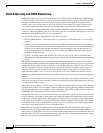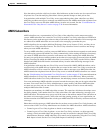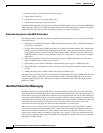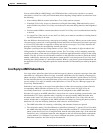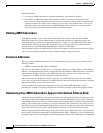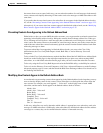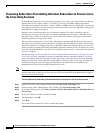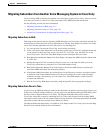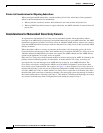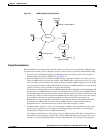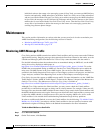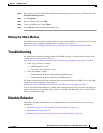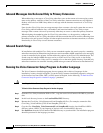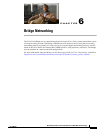
5-38
Networking Guide for Cisco Unity Release 5.x (With Microsoft Exchange)
OL-13844-01
Chapter 5 AMIS Networking
AMIS Concepts and Definitions
Private List Considerations for Migrating Subscribers
When you migrate AMIS subscribers, consider notifying Cisco Unity subscribers of these potential
effects on private distribution list membership:
• When you delete a delivery location, blind addressees are removed from all private lists.
• When an AMIS subscriber becomes a regular subscriber, the AMIS subscriber is removed from all
private lists.
Considerations for Networked Cisco Unity Servers
In organizations with multiple Cisco Unity servers networked together, when subscribers address
messages to an AMIS delivery location (by using blind addressing) or to an AMIS subscriber, the AMIS
transmission originates from the Cisco
Unity server on which the AMIS delivery location was created.
(Note that AMIS subscribers are always created on the same Cisco
Unity server as their associated AMIS
delivery locations.)
When subscribers address a message to someone on the remote voice messaging system, the Voice
Connector delivers the message to the UAmis mailbox that is associated with the Cisco
Unity server on
which the addressed AMIS delivery location was created. The AMIS schedule and the AMIS delivery
options on the pertinent Cisco
Unity server are applied.
Only one Cisco Unity server in the network needs to be licensed and set up for AMIS. If allowed by the
primary location addressing options, all subscribers, no matter which Cisco
Unity server they are
associated with, can send messages to an AMIS delivery location or to an AMIS subscriber. The
Cisco
Unity server that is configured for AMIS acts as the AMIS “bridgehead” server for the other
Cisco
Unity servers in the network. For example, in Figure 5-1, there are three Cisco Unity servers in
the network, but Unity 2 is the only server licensed and configured for AMIS. Unity 2 places and receives
all of the AMIS calls. Thus, no matter which Cisco
Unity server a subscriber is associated with, when
the subscriber sends a message to someone on another voice messaging system, the message is routed to
the UAmis mailbox that is associated with Unity 2. This mailbox is homed on the Exchange server that
was selected in the Message Store Configuration wizard during the setup of Unity 2.



